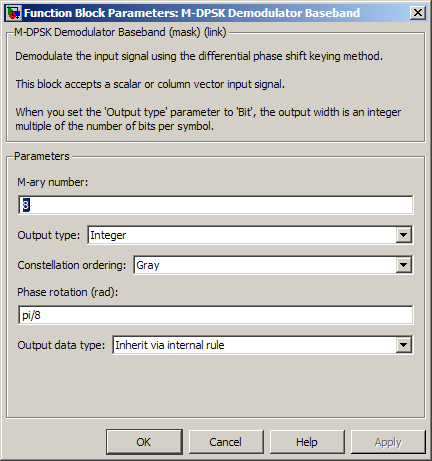M-DPSK Demodulator Baseband
Demodulate DPSK-modulated data
Library
PM, in Digital Baseband sublibrary of Modulation
Description
The M-DPSK Demodulator Baseband block demodulates a signal that was modulated using the M-ary differential phase shift keying method. The input is a baseband representation of the modulated signal. The input and output for this block are discrete-time signals. This block accepts a scalar-valued or column vector input signal. For information about the data types each block port supports, see the Supported Data Types table on this page.
The M-ary number parameter, M, is the number of possible output
symbols that can immediately follow a given output symbol. The block compares the
current symbol to the previous symbol. The block's first output is the initial condition
of zero (or a group of zeros, if the Output type parameter is set
to Bit) because there is no previous symbol.
Integer-Valued Signals and Binary-Valued Signals
If you set the Output type parameter to
Integer, then the block demodulates a phase
difference of
θ + 2πk/M
to k, where θ represents the Phase
rotation parameter and k represents an integer
between 0 and M-1.
When you set the Output type parameter to
Bit, the block outputs binary-valued signals that represent
integers. The block represents each integer using a group of K =
log2(M) bits, where K
represents the number of bits per symbol. The output vector length must be an integer
multiple of K.
In binary output mode, the symbols can be either binary-demapped or Gray-demapped. The Constellation ordering parameter indicates how the block maps an integer to a corresponding group of K output bits. See the reference pages for the M-DPSK Modulator Baseband and M-PSK Modulator Baseband blocks for details.
Dialog Box

- M-ary number
The number of possible modulated symbols that can immediately follow a given symbol.
- Output type
Determines whether the output consists of integers or groups of bits.
- Constellation ordering
Determines how the block maps each integer to a group of output bits.
- Phase rotation (rad)
This phase difference between the current and previous modulated symbols that results in an output of zero.
- Output data type
When the parameter is set to
'Inherit via internal rule'(default setting), the block will inherit the output data type from the input port. The output data type will be the same as the input data type if the input is of typesingleordouble.For integer outputs, this block can output the data types
int8,uint8,int16,uint16,int32,uint32,single, anddouble. For bit outputs, output can beint8,uint8,int16,uint16,int32,uint32,boolean,single, ordouble.
Supported Data Types
| Port | Supported Data Types |
|---|---|
Input |
|
Output |
|
Pair Block
References
[1] Pawula, R. F., "On M-ary DPSK Transmission Over Terrestrial and Satellite Channels," IEEE Transactions on Communications, Vol. COM-32, July 1984, 752-761.
Extended Capabilities
Version History
Introduced before R2006a